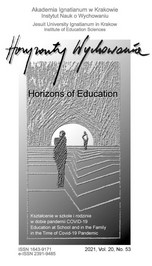Społeczna percepcja dystansu i tolerancji
The Perception of Distance and Tolerance in Society
Author(s): Janusz Kirenko, Urszula OlejnikSubject(s): Social psychology and group interaction, Pedagogy
Published by: Uniwersytet Ignatianum w Krakowie
Keywords: social perception; distance; tolerance;
Summary/Abstract: RESEARCH OBJECTIVE: The article aims to present the relationship between the notions of distance and tolerance. THE RESEARCH PROBLEM AND METHODS: The main concern of the article is to classify the features that characterize the attitudes of tolerance and distance, and to determine their inner structures. Research method: diagnostical survey including the original tolerance and distance scale (STD) and the questionnaire. THE PROCESS OF ARGUMENTATION: The notions of distance and tolerance were compared and contrasted based on the number of various definitions. Afterwards, the method of measuring those two attitudes was presented. Then, the research findings and the relationship between distance and tolerance were described. The concluding part highlighted the essence of those attitudes and the need for further research on them, as well as their role in the pedagogy studies. RESEARCH RESULTS: The conducted analyses led to creating the ranking of the features of tolerance and distance of the examined individuals. The rank data was then transformed into the standardized results and the factor analysis using the principal components method was performed, isolating the factors of distance and tolerance. Cluster analysis using the k-means method determined the distance profiles of the examined people, and then the relationships between the types of declared distance and tolerance attitudes were specified with the help of the multi-step regression method. CONCLUSIONS, INNOVATIONS, AND RECOMMENDATIONS: The research findings indicate the specific configurations of the notions characterizing the attitudes of tolerance and distance. Both of them may be observed in the positive and negative situational context, where their social perception is usually simplified, one-dimensional and stereotypical, but they translate into social awareness into human functioning in everyday life, including the relationships between them. Consequently, they should not be analysed separately. Regarding the need for education of children in the atmosphere of tolerance, the research on this phenomenon should be further developed.
Journal: Horyzonty Wychowania
- Issue Year: 19/2020
- Issue No: 50
- Page Range: 131-147
- Page Count: 17
- Language: Polish

